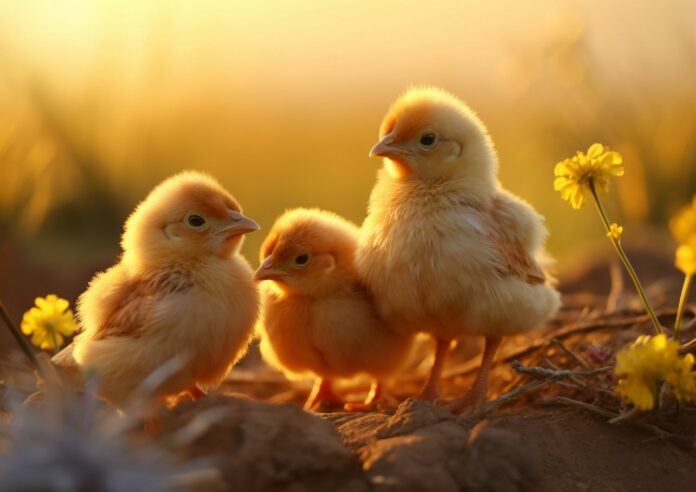Play may signify positive welfare since it reveals favorable affective states. While disparities in play between sexes have been documented in many mammalian species, there is still more research on birds. Although play behavior is known to occur in young chicks during their early ontogeny, no sex differences have been explored before.
A new study aimed to investigate potential sex effects on play ontogeny in young chickens by comparing play occurrence in young males and females of a commercial hybrid of White Leghorn. The study has shown that male baby chickens play far more than females.
This result is interesting, given that domestic chickens are directly descended from a species – red jungle fowl – with a pronounced difference between the sexes in morphology, coloration, and behavior.
First author Rebecca Oscarsson, a PhD student at Linköping University in Sweden, said, “Here we show for the first time that there are clear sex differences in the age-related development of play in chickens.”
“This difference is mainly because males engage more in social and object play.”
In mainland Southeast Asia, red junglefowl were domesticated by humans between 7,000 and 8,000 years ago. Since then, there have been numerous hybridization episodes, resulting in the genes from green, Sri Lankan, and grey junglefowl in modern domestic chickens. Males in each species are more colorful, aggressive, watchful, and able to defend their mates with food.
The scientists used the length of each baby chick’s wings to identify its sex after incubating white leghorn eggs from a farm. For the duration of the trial, they housed the chicks in cages with a sawdust floor, a heated roof, food, and water. The chicks were then moved twice weekly to bigger venues, or “playpens.” The scientists monitored the chicks for thirty minutes in these playpens, and each chick’s play was recorded at intervals of fifteen seconds. The chicks, aged six to 53 days, were observed on fifteen different days.
Scientists identified 12 different play behaviors. The flicking of the wings and frolicking were examples of locomotor play. They were playing with objects, which involved chasing after them, pecking at them, or trading them with other chicks. Jumping, sparring, and sparring stand-offs were all part of social play.
The observer placed a fake rubber worm into the playpen ten minutes into the observations. This sparked another sort of object play: worm-running, in which a chick went around with a worm in its beak. Worm-running could be the play counterpart of “tidbitting,” which is a set of courtship actions focused only on females by adult males while manipulating food items.
Play with objects was more prevalent than play with others, although play with objects was less common. Males and females alike displayed a wide range of fun actions. But there was a difference in how often they played: overall, male chicks played more than female ones. This was because there was no difference in the frequency of locomotor play between the sexes, while men engaged in object and social play more frequently.
Age since hatching also affected how often the animals played; in males, this peaked at 43 days, while in females, it peaked at 36 days. At later ages, the frequency of play gradually decreased.
According to scientists, these sex differences in chicks’ frequency of play can be explained by the high degree of sexual dimorphism of adult junglefowl. This means that male chicks would benefit more from practicing various skills related to physical ability and social tactics.
Author Dr Per Jensen, a professor at Linköping University and Oscarsson’s academic supervisor, said, “We still don’t know the adaptive function of play for any species.”
“However, the present study indicates that a possible function is to prepare animals for specific challenges they may encounter later in life. In a species like the chicken, where only males compete for territories, it makes sense that they engage in more social play as young.”
“Many questions remain unanswered concerning the adaptive functions of play, for example, its effects on later cognitive abilities. We now plan to look into the neurobiological and genetic mechanisms of play. For example, the early development of the cerebellum may be linked to play behavior.”
Journal Reference:
- Rebecca Oscarsson, Per Jensen. Male chicks play more than females – sex differences in chicken play ontogeny. Frontiers in Ethology. DOI: 10.3389/fetho.2024.1392378
